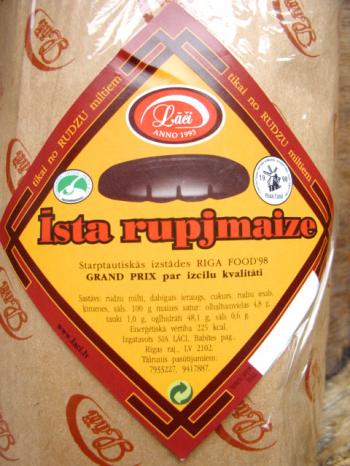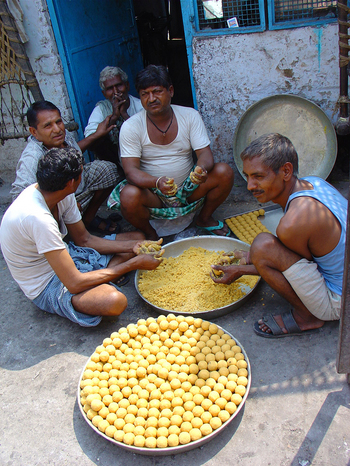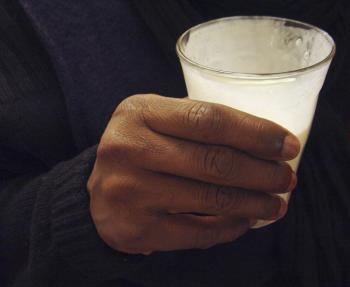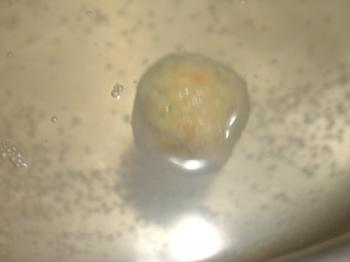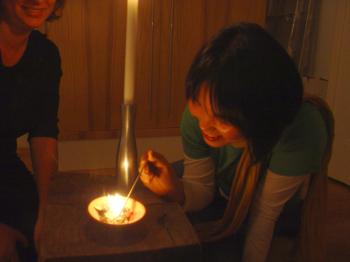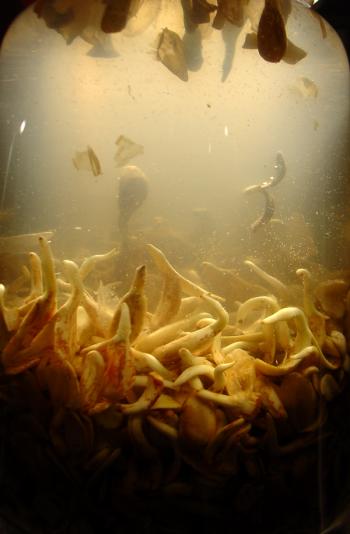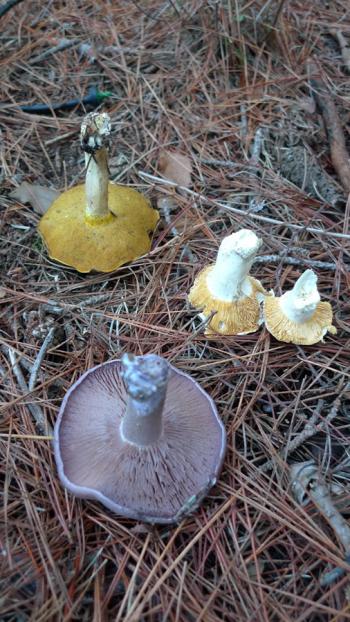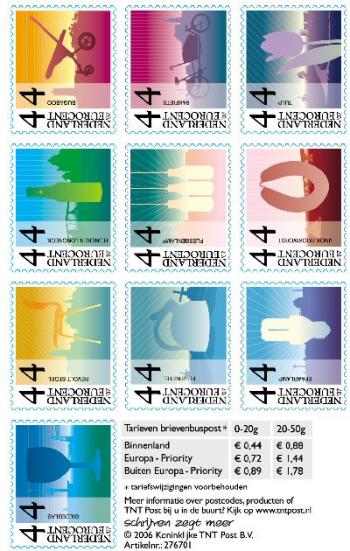Dude, lay off my
ubiquitous Dutch weener
July 27, 2007
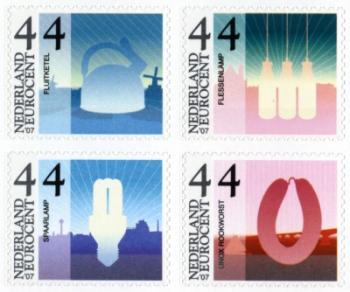
Dutch postage stamps with images of quintessentially Dutch design items incl. HEMA tea kettle Lapin. Producers of the objêts du design Ne’erlandais paid big dosh to have their stuff immortalised.
In Dutch media circles this time of year is called ‘Cucumber Time’. Supposedly all of our real journalists are on holiday 4 to 6 weeks somewhere sunny, and consequently here in the Heimatt there is a dearth of real news. This is the tempest in a teacup time of year, when it rains and rains and rains and rains and rains and rains and Dutch people tell you that it’s been a great summer. After 20 years of living in the Netherlands I still can’t figure out what this has to do with cucumbers.
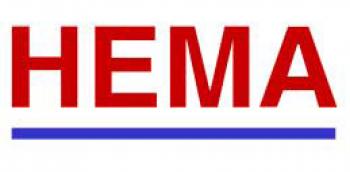
The logo of the HEMA corporation
If you’re hip to the Dutch news you certainly already know that the quintessentially Dutch ‘five and dime’ department store HEMA, is threatening the equally Dutch cultural platform Mediamatic with legal action due to an alleged brand infringement. On August 24, Mediamatic will open the exhibition titled El Hema which explores how Arabic culture is influencing the Netherlands. The exhibition intentionally challenges the notion of Dutchness by combining Arabic visual culture with that of the HEMA.
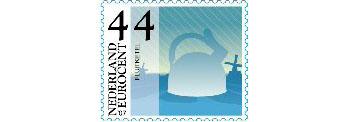
Quintessentially Dutch tea kettle on a postage stamp
Many Dutch people think of the HEMA as an expression of Dutch culture in the same way that IKEA might be considered to be an expression of Swedish culture. The HEMA is a store that sells normal stuff for the folks that consider themselves to represent the norm. The products are of good quality and the HEMA goes to some length to ensure that they are produced ethically. HEMA products (home, kitchen, office, food) are both folksy and ‘designed’ in a formal language that after 20 years can sometimes git up yer nose with its relentless practicality and cultivated quirkyness. HEMA design products are so ubiquitous that there are very few Dutch people, and by ‘them’, I mean ‘me’, that do not own that famous tea kettle that is considered Dutch enough that a corporate entity paid to have it immortalised on a postage stamp. Design is a really really really important part of Dutch culture.
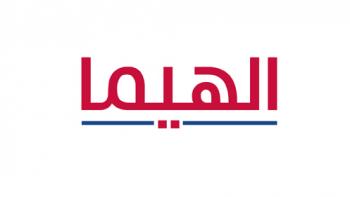
Huda Smithuijzen Abifares & Tarek Atrassi’s new logo
But what does that have to do with Arabic culture? Enter the Khatt Foundation, who have been conducting the brilliant Typographic Matchmaking Project in which an international group of graphic designers have teamed up to design Arabic companion typefaces for Dutch (Latin) fonts. Why is this important? Imagine that in the name of intercultural dialogue you need to design a poster in more than one language, using both Arabic and Latin typefaces. Imagine that your message speaks to more than just one cultural group. Turns out, 3-4 Latin typefaces are designed in the Netherlands every day, but in the Arab graphic design world there are only a handful, and from the point of view of some graphic designers, not all of these are suitable for use in conjunction with Latin typefaces. Now this is when design can get really important.
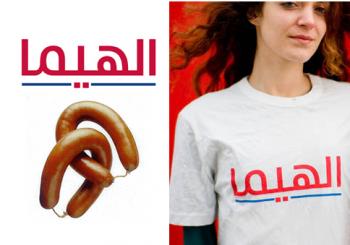
Ubiquitous HEMA weener interpreted by El Hema Halal
In the Netherlands, Thursday night is ’shopping night’ and in preparation for El Hema, Mediamatic has appropriated the koopavond for involving more people in the development of the exhibition. Although the evenings are not officially open to the public, an invitation is probably just a phone call away if you truly have something to add. The atmosphere is definitely inclusive. Yesterday after an intense telephone discussion with a colleague who insisted there was ‘no such thing as Arabic culture, the term having merely been invented to indicate countries belonging to the Arab League,’ I arrived at Mediamatic in time to view a mini Arab cinema screening, several articulate presentations of companion fonts by graphic design students from Beirut and Dubai and to dine upon delicious Persian food. Yes, Persian. Don’t say it, and don’t get me started.
The El Hema koopavond audience represented such a thorough mix of people interested in and connected to Arabic culture, that Mediamatic founder Willem Velthoven said, ‘Forget J-date, El Hema koopavond is home to all the hot mishpocha.’ Or something like that. I’m not a real journalist.
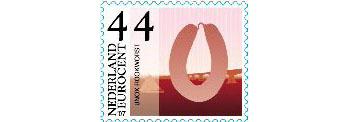
The ubiquitous UNOX weener, not to be confused with the ubiquitous HEMA weener
-
The 10 for the Netherlands series (2007) depicts:
1) the guild glasses of Andries Coupier (for Royal Leerdam)
2) the Revolt chair by Friso Kramer (for Ahrend)
3) Heineken’s Longneck bottle
4) the Bugaboo pram by Max Barenburg (for Bugaboo)
5) Tea kettle Lapin by Nicolai Carels (for HEMA)
6) Tejo Remy’s bottle lamp (for Droog Design agency)
7) the bakfiets (Fietsfabriek)
8) the Philips eco-lamp
9) the smoked sausage (by and for Unox)
10) the tulip (just read the Embarassment of Riches by Simon Schama)
- El Hema at Mediamatic
August 24 - November 3, 2007
visiting address office & workshops:
Post CS building
5th floor south
Oosterdokskade 5
Amsterdam
t: +31 20 638 9901Not to be confused with the REAL HEMA
Mediamatic’s El Hema shopping night # 6
Typographical Matchmaking Project, an initiative by Huda Smitshuijzen Abifares
Graphic designer Tarek Atrissi’s graphic design blog
FYI - Although Arab culture is not synonymous with Islamic culture, the month of Ramadan in 2007 will start on Thursday evening, the 12th of September, and will continue for 30 days until Friday, the 12th of October. The end of the fasting month Eid al-Fitr will be celebrated by observing Muslims on the sunset of Thursday, the 11th of October. Hindus begin the Navratri fasting period the very next day.
debra at 14:33 | Comments (3) | post to del.icio.us
Made in Transit,
growing food
in a waste of time
July 10, 2007
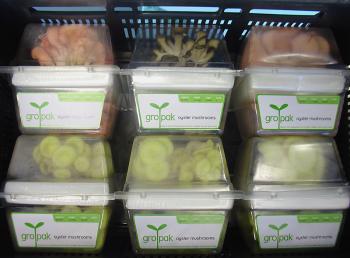
Mushrooms of the future are grown in situ in transit
When it comes to the food supply, there’s a lot of waste to go around. Agata Jaworska, a recent masters graduate from the Design Academy Eindhoven, has designed a way to use the time and space associated with transportation to grow fresh produce. Jaworska analysed the supply chain of a mushroom, and through a systems intervention was able to eliminate all of the steps that were not productive. She turned the packaging + the freight truck + the normally wasted time and space into a mushroom farm, in a total supply chain redesign, merging production with distribution.
Made in Transit animation by Agata Jaworska and Seton Beggs used entirely with permission
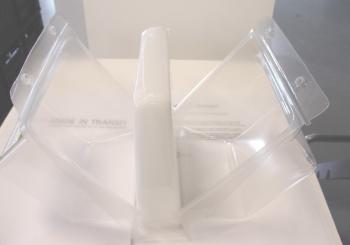
Prototype bio-degradable packaging cum growing medium innoculated with fungi spores
In her thesis Jaworska points out that transportation is normally a dormant time for produce. The food becomes trapped inventory and a lot of energy must be spent keeping it fresh. This means that the distribution system must be fast and the environment must be cool. But freight trucks aren’t the least bit cool. In fact they generate a lot of warmth en route, and that warmth is just what a growing mushroom needs most aside from darkness. In the Made in Transit concept, the need to heat the cool environment of the traditional mushroom farm is eliminated and the warmth naturally produced by the transport vehicle is used to do the growing.
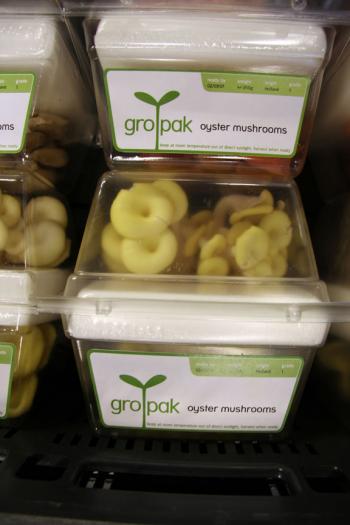
Oyster mushrooms of the future travelling first class, image by Agata Jaworska used with permission
Jaworska notes that what used to be simple packet distribution is now evolving into a completely new field. Her thesis is riddled with examples from companies like UPS, DHL, FedEx-Kinkos and the shipping company Maersk, that are becoming involved in the production of goods along the way, stepping outside the traditional boundaries of distribution.
The burning question is of course which commodities can best benefit from the Made in Transit concept. At the moment the (agricultural) University of Wageningen is chomping at the bit to develop this process further with Jaworska. In the dog-eat-dog world of Dutch mushroom farming, magically transforming freight trucks into (let’s just be naïve) organic mobile farms, eliminating the need for independent growing spaces and (ahem) labour, is nothing short of a paradigm shift.
- Press release freely translated from the Dutch: Master Pieces 2007. Seven freshly graduated masters from the Design Academy Eindhoven’s department, Conceptual Design in Context, will be showing their work at the droog-at-home design gallery on Staalstraat 7a-7b in Amsterdam on July 10, at 18h. Free drinks. Just kidding.
- Agata Jaworska can be reached at agata at agatajaworski dot com
debra at 16:43 | Comments (7) | post to del.icio.us
Controversial snacks and mild-mannered symposium
July 7, 2007
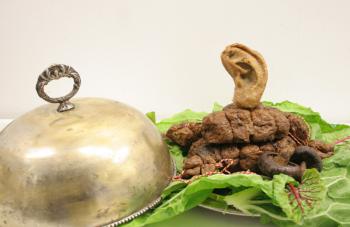
Wandering Banquet’s wheat meat piéce montée was not just another secret ingredient. You hear me talkin’?
Dutch fire marshalls the world over will be unhappy to read that last Friday’s Food, Art and Science symposium at the Centraal Museum in Utrecht was filled way beyond capacity. Lab meat is apparently all the shizz and more than 100 people showed up, including film crews accompanying the journalists who invariably got their facts skewed.
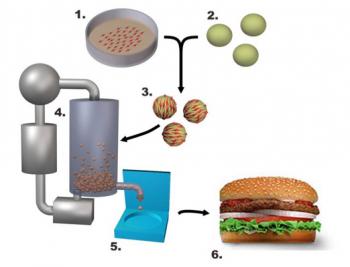
Illustration of a possibility used entirely w/o permission
Prof. Henk Haagsman, meat scientist from the U of U kicked off the event with an account of the ecological impact of our current modes of meat production. If your secret symposium dream was laced with cat fights, bitch-slaps, and shoes hurled hard (as was mine), Haagsman’s unassuming demeanor was nothing short of unnerving. He is a perfect spokesperson for an industry-to-be already supported by a consortium that counts Sara-Lee Foods, Smithfields and Stegeman among its members. He can explain the technical ins and outs of lab meat in a way that any layman could understand. But in the end, Haagsman is a scientist not an evangelist, and points out that he sees lab grown meat as merely another possible alternative to meat grown meat. And who can argue with that? (Yeah, you in the front…)
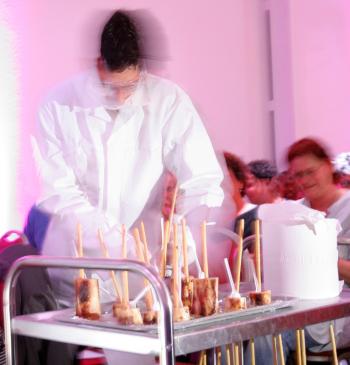
Bone marrow transplant, first snack of the evening.
After each speaker, Wandering Banquets rolled out a controversial snack. First up was a hunk of roasted cow bone brimming with melting marrow, sprinkled with sea salt and gored with a bread stick. Although I call myself an environmental vegetarian, I can’t tell you how fast I tucked into that thing, wondering all the while why I don’t eat marrow every single day of my life, and wondering even more, when exactly I had become my own bone-sucking mother. Waste not, want not, gimme that bone, Bone. Funnily, the potentially squeamish in the audience had no idea what they were eating and only found out when I spilled the beans at the end of the evening. The guy sitting behind me, clearly macroneurotic, thought it was disgusting (not true) and ‘very fatty’. Yeah, there may be a tiny bit of fat inside that bone.
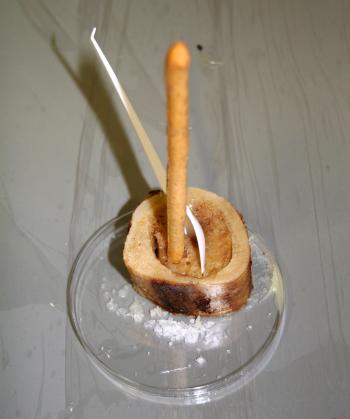
Roasted bone marrow and sea salt w/bread stick
Dr. Cor van der Weele from the U of Wageningen was the designated ethicist and I really appreciated her using examples from contemporary art (I mean bio-art) to explain the moral dilemnas of this subject. After pointing out the role of ethics in technology, Dr. vd Weele took a three-pronged approach to analyse the moral terrain and very helpfully came up with three different conclusions. Of all the speakers, her presentation left me with the most questions for further discussion. For example, why is it OK to make a moral analysis of an isolated subject like lab meat, extracting it from the larger system to which it belongs - the industrial food complex? And why, without meaning to sound Ludditic or rhetoric, is technological progression considered to be valuable in and of itself? We sometimes question art for art’s sake. Why in this instance don’t we question technology for technology’s sake?
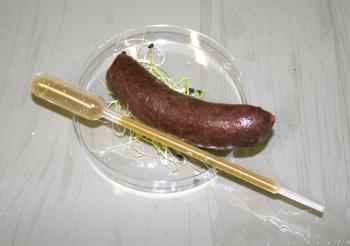
Blood sausage w/apple pipette on a bed of leek sprouts
Shortly after devouring the baby blood sausage with apple pipette, designated philosopher Dr. Michiel Korthals stated that it was not the job of ethicists to police technological progression. New technological ideas require new societal arrangements and neither ethics nor technology should have the upper hand. He called for the co-evolution of ethics and the technological object in question. Can’t say that I agree with him about that, looking back with 20/20 hindsight.
Korthals introduced the notion of scripts, or the use of future scenarios by scientists to imagine the effects of a given technological object as input in society, describing the utopian, optimsitic, pessimistic and most interesting, the ambivalent scripts associated with lab grown meat. He cited as an example how the pill divorced one of the more fun acts of sex from its causal relationship with pregnancy. Could lab meat or any other technologically produced foodstuff separate the culturally rich acts of eating and farming from the side effects associated with these acts? Korthals had no answers but was rather thorough in presenting all manner of scripts, one of which was a de-centralised production of lab meat, meaning home grown. Almost rhymes with home-cooked!
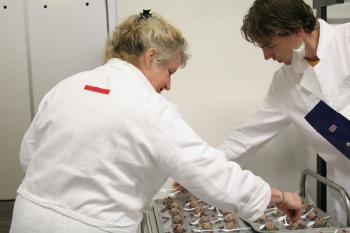
Queen of snacks, snack of Queens, rice and beans!
Last up was me moi-meme, who tried to bring a whole systems approach by way of a florid description of 1970’s California food subculture. I spoke about why it’s so difficult to see food as part of a very large system, defining whole food along the way. Because I’m good buddies with the food designers, I was hip to the menu beforehand and used the lineup to elaborate my response to the other speakers. Divided into four delicious snacks, the basic components of the menu were soybeans, bones, blood, rice & beans, and wheat meat. The edamame starter was a springboard for talking about techno-industrial vs. whole foods and that when soybeans cease to be soybeans, they have historically been cast as the ‘dictators’ choice’ in the firmament of utopian technofood. Coincidence?
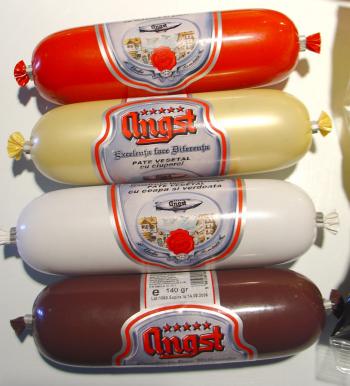
Will you be having the angst or the angst?
The bone and blood courses were an expression of the necessity to eat and enjoy the entire animal, from snout to tail. The three previous speakers cited statistics depicting the impact of livestock, neglecting to mention that those statistics change when we consider animal protein consumption as steaks, breasts and bellies. There’s more to meat than T&A.
The meat ball snack was in fact my plea for plain ‘ole rice & beans. What I find most vexing is that an entire technological trajectory and industrial process needs to be set up to produce a meat substitute. What’s wrong with rice and beans? That’s what most folks eat when they can’t, won’t or don’t eat meat. Depressing landuse statistics (1,4 ha/pp) refer to omnivorous practice, not vegetarian (as low as 0,2 ha/pp) or folks that occasionally tuck in. When even the highly conservative FAO can be clear about the environmental impact of livestock, why not wonder more about the ethics of entitlement?
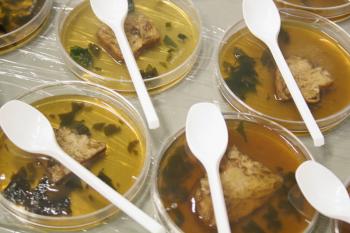
Seitan snack in agar agar aspic
My favourite menu item was the last, a thin slice of marinated seitan on agar agar aspic. As we had gathered to discuss this technological future food, with its resource-rich trajectory and not a shred of lab meat expected on the public plate before 2012 AD, I thought it only fair to point out that home protein production is very much right here, right now if you can just afford the initial investment of white flour, water and a bowl. In terms of protein, 100 grams of wheat meat weighs in at half a percentage point shy of cheese, but still 2 percentage points higher than red meat. I’m not sure about the protein capabilities of the projected lab meat, but I’m thinking that home grown protein is not so much in need of product development as process awareness. Amen.
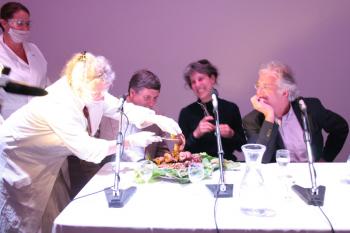
The panel gets an earful from Wandering Banquets. Click the image. Missing is Dr. Cor van der Weele.
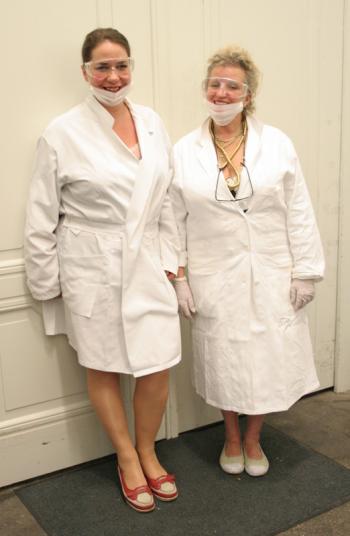
Wandering Banquets’ Overakker and de Jong
All photos in this entry are by Tomoko Take.
The Dutch slang word for lab grown meat is kweekvlees. Sounds like Quake Flace.
Links to pesky bits about meat and wheat meat:
- Culiblog on the ‘dictators’ choice’: Soy Story
- Culiblog on home protein production: Glutinous Maximus
- Culiblog on vegetarian subculture: Learning through your ass
- FAO Newsroom
On emissions: According to a new report published by the United Nations Food and Agriculture Organization, the livestock sector generates more greenhouse gas emissions as measured in CO2 equivalent - 18%, than the transport sector. It is also a major source of land and water degradation.
The livestock sector accounts for the following percentages of total emissions:
carbon dioxide - C02 - 9%
nitrous oxide - N20 - 65%
methane - CH4 - 37%
ammonia - NH3 - 64%On land use: 30% uses of the earth’s surface
33% of all global arable land is used to feed livestock
Meat and dairy animals account for 20% of the earth’s biomassGlobal meat production is projected to more than double from 229 million tonnes in 1999/2001 to 465 million tonnes in 2050, while milk output is set to climb from 580 to 1043 million tonnes.
- World Watch
On energy: Energy Consumption & Global Warming: It takes far more fossil-fuel energy to produce and transport meat than to deliver equivalent amounts of protein from plant sources. This heavy use of carbon-rich fuels also contributes significantly to the emissions of global-warming gases.
On land use: Food Productivity of Farmland: In the U.S., 56 million acres of land produce hay for livestock. Only 4 million acres produce vegetables for human consumption, reports the US Department of Commerce. Such inefficient use of land means that food production will not keep up with population growth. - Toronto Vegetarian Association
On land use: A meat-based diet requires 7 times more land than a plant-based diet. 0,2 ha (plant-based diet) vs. 1,4 ha
On efficiency: 6,2 k grain : 1 kilo animal protein (pigs 8,4, chicken 3,2) Most energy is spent on movement not weight gain.
40 kilos of shit : 1 kilo of edible beef
On energy use associated with meat-based diet: According to one study, meat production requires 10 to 20 times more energy per edible tonne than grain production.6 Growing feed crops requires extensive energy for ploughing, harvesting, pumping irrigation water, transportation, and producing fertilizer and pesticides. Once grown, the crops are processed using additional energy. Livestock travel an average of 600 kilometres (in North America). Animal products tend to require more energy for processing, packaging, and refrigeration than plant-based foods. In contrast, many vegetables, fruit, grains and tubers require no refrigeration and little or no processing. - Vegan Outreach (oh don’t be so judgemental)
On land use: A meat-based diet requires 7 times more land than a plant-based diet. The average agricultural land area in North America is 1.6 hectares per person (1.4 hectares after adjusting for the export of grain). Yet there are many countries in the world that use as little as 0.2 hectares (half acre) of farmland per person. These are the countries with plant-based diets.
On land degradation: Expansion of livestock, key factor in deforestation esp in Latin America. 70% of deforested land (in LA) is occupied by pastures and feedcrops (from FAO report)
On water use: 8% of global human water use for livestock (primarily irrigation of feedcrops)
On missions: 18% total emissions of C02 attributed to livestock = more than the transportation sector
On biodiversity: Leading driver in reduction of global biodiversity - Greenhouse gasses on our plate at Jean Marc Jancovici’s Manicore website
- Not while I’m eating, a study of human response to food as part of a system - by Axel Aubrun
- Michiel Korthals is author of the Dutch language book Voor het eten (Boom Publishers)
debra at 12:58 | Comments (4) | post to del.icio.us

